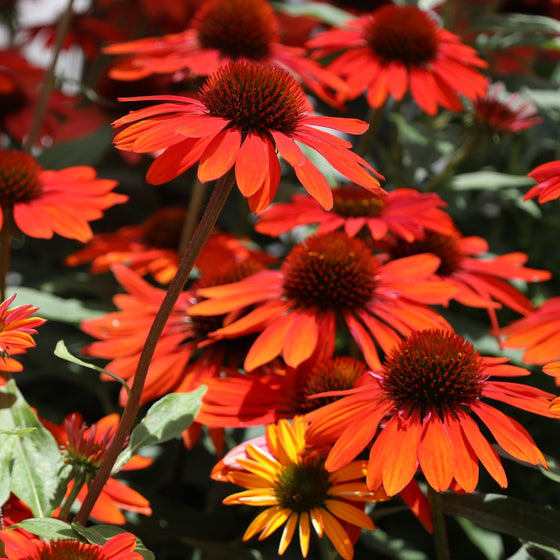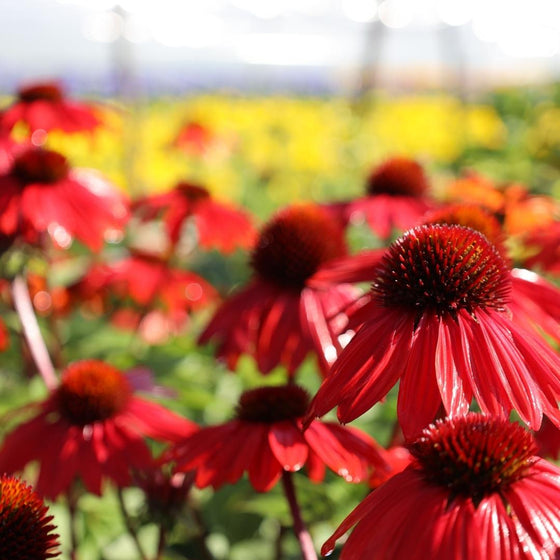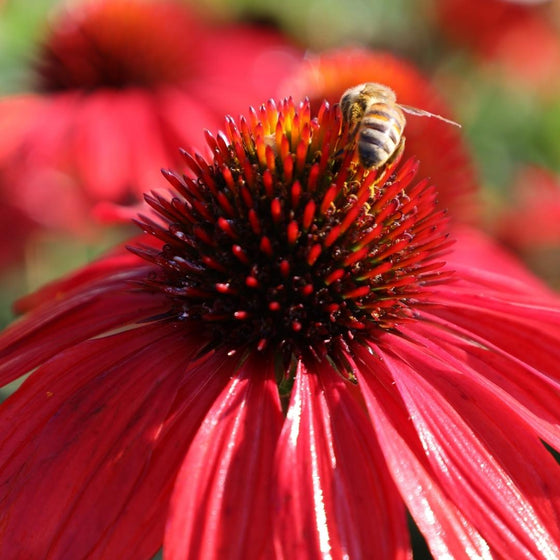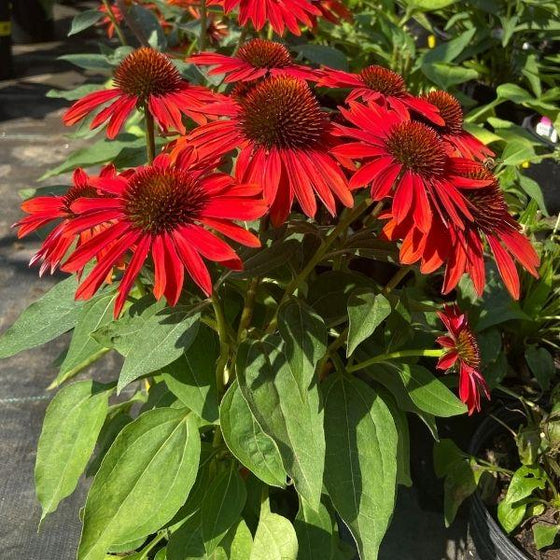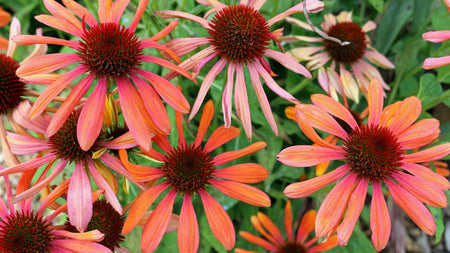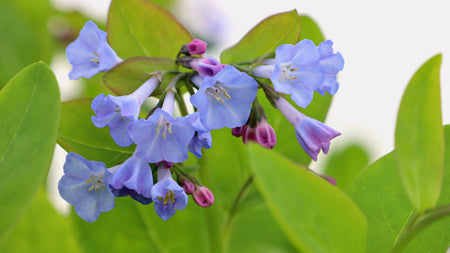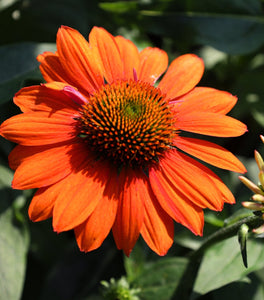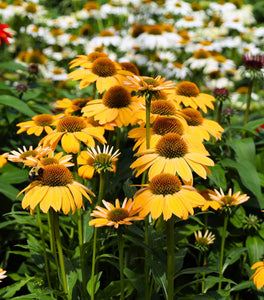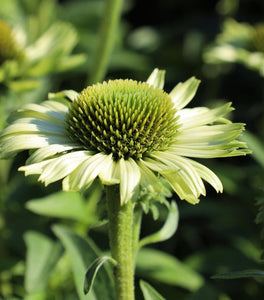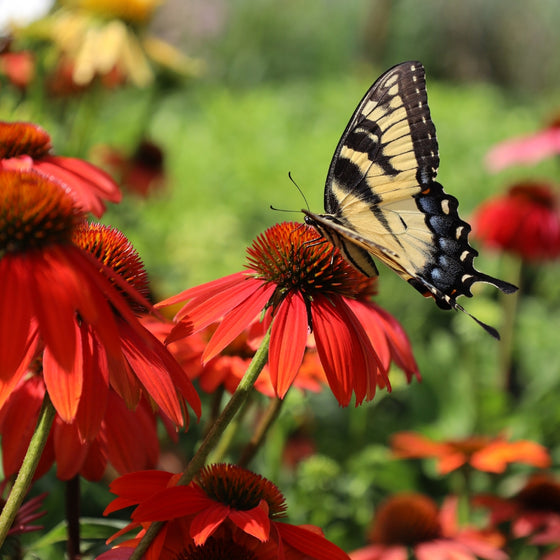
Images Depict Mature Plants
Echinacea Sombrero® Sangrita Coneflower – Vibrant Red Blooms, Drought Tolerant & Pollinator Friendly
A fiesta of color for your sunny garden.
Bring your garden to life with the stunning Echinacea Sombrero® Sangrita, a compact coneflower that dazzles with vibrant, long-lasting red blooms from early summer through fall. This powerhouse perennial stands just 18–24 inches tall, making it ideal for borders, containers, and pollinator gardens. Each daisy-like flower glows with deep red petals surrounding a coppery-orange cone, creating the kind of color intensity that stands out against green foliage and other perennials.
Low-maintenance, high-performance perennial.
The Sombrero series is renowned for producing reliable, long-blooming plants that are exceptionally easy to grow. Sombrero Sangrita thrives in full sun, tolerates heat and humidity, and once established, becomes highly drought-tolerant. Its sturdy, upright stems resist flopping even in heavy rain, making it a perfect fit for professional landscapes and busy gardeners who crave beauty without the upkeep.
Pollinator favorite with substantial garden value.
Butterflies, bees, and hummingbirds adore Echinacea Sombrero Sangrita, making it a centerpiece of any eco-friendly garden. As summer progresses, the blooms gradually age into softer coral tones, adding layers of texture and visual interest. The dried seed heads that follow are also beloved by songbirds, extending the garden's appeal well into fall and winter.
A durable and dependable garden performer.
Beyond its beauty, Sombrero Sangrita Echinacea is exceptionally hardy—cold-tolerant down to Zone 4 and heat-resistant through Zone 9. It’s deer and rabbit-resistant, making it a safe choice for rural or suburban gardens. Plant it once and enjoy years of rich red blooms, effortless maintenance, and four-season interest.
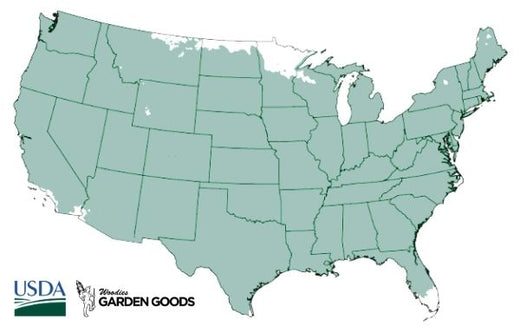
| Hardiness Zone: | 4-9 |
|---|---|
| Mature Height: | 1 to 2 Feet |
| Mature Width: | 20 to 24 Inches |
| Sunlight: | Full sun |
| Water Requirements: | Average |
| Bloom Time | Summer |
| Selling Points: | Long-blooming; fragrant; attracts butterflies and pollinators |
How to Care for Echinacea Sombrero Sangrita Coneflower
Be sure to read our planting instructions to ensure a healthy and happy Echinacea Sombrero Sangrita plant for years to come!
How do I plant Echinacea Sombrero Sangrita Coneflower?
Choose a sunny location that receives at least 6 hours of sunlight daily. Dig a hole twice as wide as the root ball but no deeper. Set the plant so the crown sits level with the soil surface, then backfill with native soil mixed with compost to improve drainage. Water thoroughly after planting. Add a 2-inch layer of mulch to retain moisture and regulate temperature. Sombrero Sangrita prefers well-drained soil and will not tolerate soggy conditions, so avoid planting in low or wet areas.
How often should I water my Sombrero Sangrita Echinacea?
Water deeply once a week during the first growing season to encourage a strong root system. Once established, Echinacea Sombrero Sangrita is drought tolerant and can handle extended dry periods without stress. Be cautious not to overwater; coneflowers prefer slightly dry soil conditions. During prolonged drought, a deep soak every 10–14 days is sufficient to keep plants healthy and blooming.
When should I fertilize Echinacea Sombrero Sangrita?
Fertilize in early spring with a balanced, slow-release fertilizer (10-10-10) or organic compost before new growth begins. Over-fertilizing can lead to fewer blooms, so feed lightly. Adding compost or aged manure annually helps replenish nutrients and maintain rich, loamy soil. Proper feeding ensures vigorous blooms and strong stems throughout the growing season.

How and when should I prune Echinacea Sombrero Sangrita?
Deadhead spent flowers regularly to encourage continuous blooming. In late fall, allow some seed heads to remain to feed birds and add winter texture. In early spring, cut back all stems to about 2 inches above ground before new growth emerges. This promotes fresh, uniform regrowth and helps maintain the plant’s compact, mounded habit.

